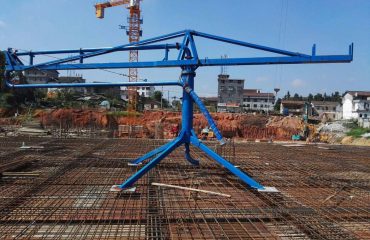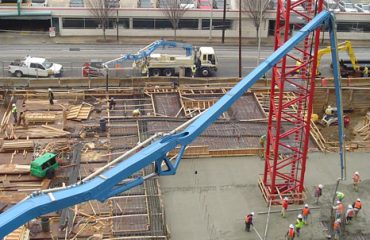Flow in a pipe
Fluid flow in a pipe depends on the pressure applied, the radius of the pipe and
the viscosity of the fluid. Per un fluido newtoniano, the flow is directly proportional to the
viscosity, che è una costante. Per un fluido non newtoniano avente una viscosità che dipende
3
sullo stress di taglio, come fughe e calcestruzzi, the flow rate is a complicated function
of the viscosity.
La viscosità () di un fluido è il rapporto tra lo sforzo di taglio () alla velocità di taglio (̇):
= / ̇. This definition is convenient for Newtonian fluids, and certain non-Newtonian
fluidi. In other cases, however, an engineering approach to the description of a fluid can
simplify the analysis. For instance if the fluid is approximated as a power law fluid, it can
be described by Eq. 1 where τ is the shear stress, K the power law consistency index, ̇
the shear rate, n the power law exponent:
n = Kγτ [ 1]
The corresponding velocity profile in a circular pipe is then given by equation 2 [4]:
1 1/
2
(3 1) ( ) 1 ( ) ( 1)
n
p p
Qn r v r
p Rn R
+ + = − +
[ 2]
where v is the fluid velocity as a function of the radial position, r , in the pipe, Q the
volumetric flow rate, and Rp the pipe radius. The fluid power law consistency index, K,
can be calculated using the following equation 3 [4], which requires a pressure drop
measurement over a certain length:
3 3 1/
2
n
n
p
P Q K R
L p
∆ − − =
[ 3]
where ∆P is the pressure drop, and L the distance between the pressure sensors. Il
exponent n and the factor K could also be determined via equation 1 from rheological
measurements of the fluid through a rheometer if available. But equations 2 e 3 could
also be used to determine n and K from the pipe flow, in absence of a suitable rheometer.
The shear rate at the wall surface is calculated using the following equation [5, 6]:
3
3 1 ( ) p
p
n Q r R
n R γ
p
+ = = [ 4]
The local shear stress is
τ = ∆rP L / 2 [ 5]
The equations 1 through 5 describe flow of a homogenous fluid in a pipe.
però, concrete is more a complex fluid because it contains aggregates with a wide
4
range of sizes. These aggregates interact with the pipe walls and each other, creating
inhomogeneities in the fluid. Thus, concrete flow in a pipe typically occurs in three layers
or regions [5, 6] as shown in Figure 1:
• Slip-layer or lubrication layer,
• The shearing region or layer, e
• The inner concrete or layer, also referred to as a plug flow layer
The thickness of the slip layer depends upon the tribology of the material adjacent
to the pipe material. Tribology is “the science and technology concerned with interacting
surfaces in relative motion, including friction, lubrication, Indossare, and erosion” [7]. Il
thickness of, and the velocity profile within, the shearing layer depends upon the
viscosity and the yield stress. The thickness of the inner layer depends upon the yield
stress.
The composition and physical characteristics of each layer are difficult to know.
Their characterization requires the extraction of material from disparate regions. Il
slip/lubrication layer contains mainly cement paste and possibly very small sand particles
[8], while the inner layer contains coarse aggregates. Also, the diameter of the inner layer
or the thickness of the slip-layer is unknown. It is conceivable that prediction of concrete
flow in a pipe will need the characterization of each of the layers.
Figure 1: Profile of flow of concrete in a pipe [6]
2.2. Slip-layer
Several research groups have investigated the slip-layer of concrete flow in a
tubo. Choi et al. [5, 6] measured the thickness of the slip-layer using an Ultrasonic
Velocity Profiler (UVP) in pumping circuits using industrial equipment and found that
there is a 2 mm thick layer along the inner surface of the pipe. però, the layer
thickness could vary depending on the mixture proportions and the pipe configuration.
Kaplan [9] reported that the flow of concrete in a pipe is mainly related to the
viscosity of the slip-layer and that its properties could be measured by tribometry. He
found that the correlation between the properties of the bulk material as measured in a
5
rheometer and the properties of the slip-layer was weak. Jacobsen et al. [10] showed by
using colored concrete that the velocity profile of the concrete resembled that of plug
flow in the pipe center, and non-moving slip-layer, similar to that shown in Figure 1.
Kwon et al.[11, 12] measured the rheological properties of concrete before and
after pumping while monitoring the pressure and flow rate and found that while there was
Nessuna correlazione tra proprietà reologiche cemento sfuso, ad es., viscosità e resa
stress, e portate, C'era una forte correlazione tra le proprietà dello strato antiscivolo
e portate. Così hanno dedotto che lo strato di slittamento è il fattore determinante per
prevedere che il calcestruzzo sarà portata in un tubo. Hanno poi proceduto a sviluppare un tribometro
che è un reometro coassiale con un caschetto liscio in acciaio o ricoperti di gomma per
simulare lo strato di slittamento del tubo.
ONG et al.[13] osservato che lo strato di slittamento è tra 1 mm a 9 spessore mm, da
visualizzare il flusso di materiale in reometro. Ha analizzato il livello e ha trovato che esso
contenuto di sabbia con una granulometria inferiore a 0.25 mm. Ciò implica che ci sia un
migrazione di aggregati grossi da vicino alla parete al centro del tubo dove il
velocità di taglio è inferiore a quello trovato nei pressi delle mura.
2.3. Pressione di pompaggio
Un altro fattore di pompaggio è la pressione applicata al materiale per spostarlo
attraverso il tubo. Rio et al.. [8] ha mostrato con un gran numero di pompaggio le prove che il
relationship between the pressure of the pump and the flow rate of the material is linear:
P k kQ = +1 2 [ 6]
Dove 1 k and 2 k are two empirical parameters that depend on the material and other
experimental conditions. Rio et al.. concluded that the two parameters can be used to
characterize a specific mixture. Rio et al.. [8] advocated that the knowledge of these
parameters for a specific mixture and pumping circuit could be used as a quality control
tool to ensure that the applied pressure is sufficient to ensure the desired flow rate.
Feys et al. [14] established an empirical relationship between the plastic viscosity
of the concrete at a shear rate of 10 s-1 and the pressure gradient in a pipe. If the pressure
gradient is too low, the material will not move through the pipe. Feys mentioned two
issues relevant to the prediction of flow in a pipe: 1) the slip-layer influence is very
important, but it is not well understood and is difficult to measure; 2) the shear rates in
the pipe are spatially and temporally varying. One solution for the effect of the slip-layer
would be to measure its rheological properties, if it could be isolated and extracted.
Modeling of the flow in a pipe might help resolve the second issue. Feys et al. [14] anche
observed that the pumping of self-consolidating concrete (SCC) requires a higher
pressione, while the yield stress is almost zero, but the plastic viscosity is higher than that
for normal concrete. This could be due to the slip-layer (Figure 1) that would require a
higher shear stress at the same shear rate due to the increased viscosity.
- HOMEPAGE
- Chi Siamo
- PRODOTTI
- Tubo in acciaio legato
- Flangia per tubo in acciaio
- Riduttore per tubi in acciaio
- Gomito del tubo d'acciaio
- Raccordi per tubi scanalati
- Pompa e parti in cemento
- Tubo pompa per calcestruzzo
- Pompa per calcestruzzo gomito
- Morsetto di pompa per calcestruzzo
- Pompa per calcestruzzo Bend
- Flangia della pompa per calcestruzzo
- Calcestruzzo di immissione
- Parti di pompa per calcestruzzo
- Pistone pompa per calcestruzzo
- Tubo di gomma della pompa per calcestruzzo
- Pompa per calcestruzzo lamiera antiusura e anello di usura
- Cilindro di pompa per calcestruzzo
- Guarnizione pompa per calcestruzzo
- PUTZMEISTER
- SCHWING
- Pali a vite di terra
- CLIENT & ESPOSIZIONE
- CONOSCENZE TECNICHE
- CONTATTACI




È necessario essere registrato nel per inviare un commento.